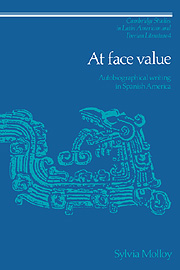Book contents
- Frontmatter
- Contents
- Acknowledgments
- Introduction
- PART I THE SCENE OF READING
- PART II CHILDHOOD AND FAMILY TALES
- 4 Childhood and exile: the Cuban paradise of the Countess of Merlin
- 5 A school for life: Miguel Cané's Juvenilia
- 6 The search for Utopia: Picón Salas looks forward to the past
- 7 A game of cutouts: Norah Lange's Cuadernos de infancia
- PART III MEMORY, LINEAGE AND REPRESENTATION
- Notes
- Bibliography
- Index
4 - Childhood and exile: the Cuban paradise of the Countess of Merlin
Published online by Cambridge University Press: 14 September 2009
- Frontmatter
- Contents
- Acknowledgments
- Introduction
- PART I THE SCENE OF READING
- PART II CHILDHOOD AND FAMILY TALES
- 4 Childhood and exile: the Cuban paradise of the Countess of Merlin
- 5 A school for life: Miguel Cané's Juvenilia
- 6 The search for Utopia: Picón Salas looks forward to the past
- 7 A game of cutouts: Norah Lange's Cuadernos de infancia
- PART III MEMORY, LINEAGE AND REPRESENTATION
- Notes
- Bibliography
- Index
Summary
One writes of such things in order to transmit to
others the world view that one carries within.
Ernest Renan, Souvenirs d'enfanceOf the many fictions the autobiographer resorts to in order to achieve being in the text, the one dealing with the family past, and childhood in particular, would seem, at first glance, the easiest. It is removed enough from the moment of writing to be seen as a self-contained unit that the adult can deal with in a detached yet not unsympathetic way. It is endorsed by the most elementary and unquestionable of legalities, that of the birth certificate, and finally, in accordance with a narrative convention that sees topology and genealogy – the where and the where from – as necessary beginnings to the telling of lives, it is pretty much inevitable.
However, this has not always been the case. The importance given childhood in literature, autobiographical or otherwise, is, as is common knowledge, relatively recent: lives – or rather the stories of lives – had other beginnings. As in Epinal engravings, children were depicted less as themselves than as miniature grown-ups, just ripe for adulthood. Prior to the nineteenth century, self-writing had little use for the subject's first years, except as a pre-history of the self. The life stories written in Spanish America before the nineteenth century are no exception; references to childhood in Colonial times are indeed so rare that when they do appear the modern reader tends to overread them.
- Type
- Chapter
- Information
- At Face ValueAutobiographical Writing in Spanish America, pp. 79 - 96Publisher: Cambridge University PressPrint publication year: 1991
- 8
- Cited by

